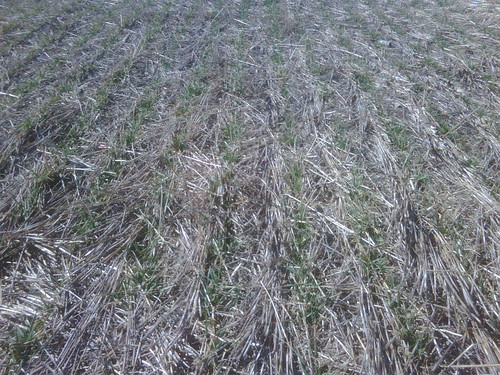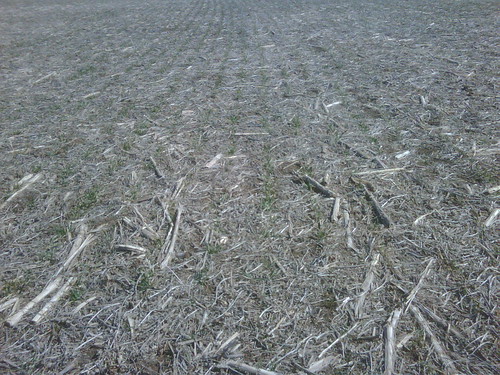
This field is wheat seeded directly into last year's wheat stubble. Second year of wheat is the best yielding wheat in our rotation.

This field was planted in soybean stubble. The bigger pieces of crop residue is from the previous grain sorghum crop. Our stand tends to be a little thin after soybeans, some of it is from the heavy trash, there is some thoughts floating around glyphosate, Roundup's active ingredient, this will need more investigation.
![IMG00124-20110312-1550[1]](http://farm6.static.flickr.com/5017/5521240601_c3c56e2dd8.jpg)
This field was seeded into sunflower stubble. We seem to get real good stands and yields will rival wheat planted into wheat stubble following sunflowers. This field happens to be Hard White Winter Wheat, it's more of a specialty wheat that we only plant a few acres of. The more common wheat for my area is Hard Red Winter Wheat. The only real noticeable difference in growing white wheat is slightly less disease resistance and slightly more head sprout in a very wet summer. I prefer the taste of white wheat, it seems to be a little sweeter taste.
We started fertilizing our wheat. We use a liquid fertilizer solution that is 28% nitrogen. We are trying to fertilize it as late as we can, but before the plant needs it and becomes deficient. By late fertilizing we are attempting to add as much protein to grain as possible, our area isn't known for producing high protein wheat and is mixed with wheat from western Kansas. If we let our wheat become deficient then we lose yield potential because the plant will only make the amount of grain that it can support even if nutrients are provided later when it needs them.
My wife and I drove home from Florida after attending the Commodity Classic going through Texas north of Dallas, the middle of Oklahoma and Kansas the wheat looked pretty decent at highway speed or faster. The western part of Kansas is going to have a poor crop due to not having enough top soil moisture last fall at seeding time. The poorer wheat will be destroyed, some never emerged last fall and I've heard reports that many fields weren't even seeded due to lack of rain.
